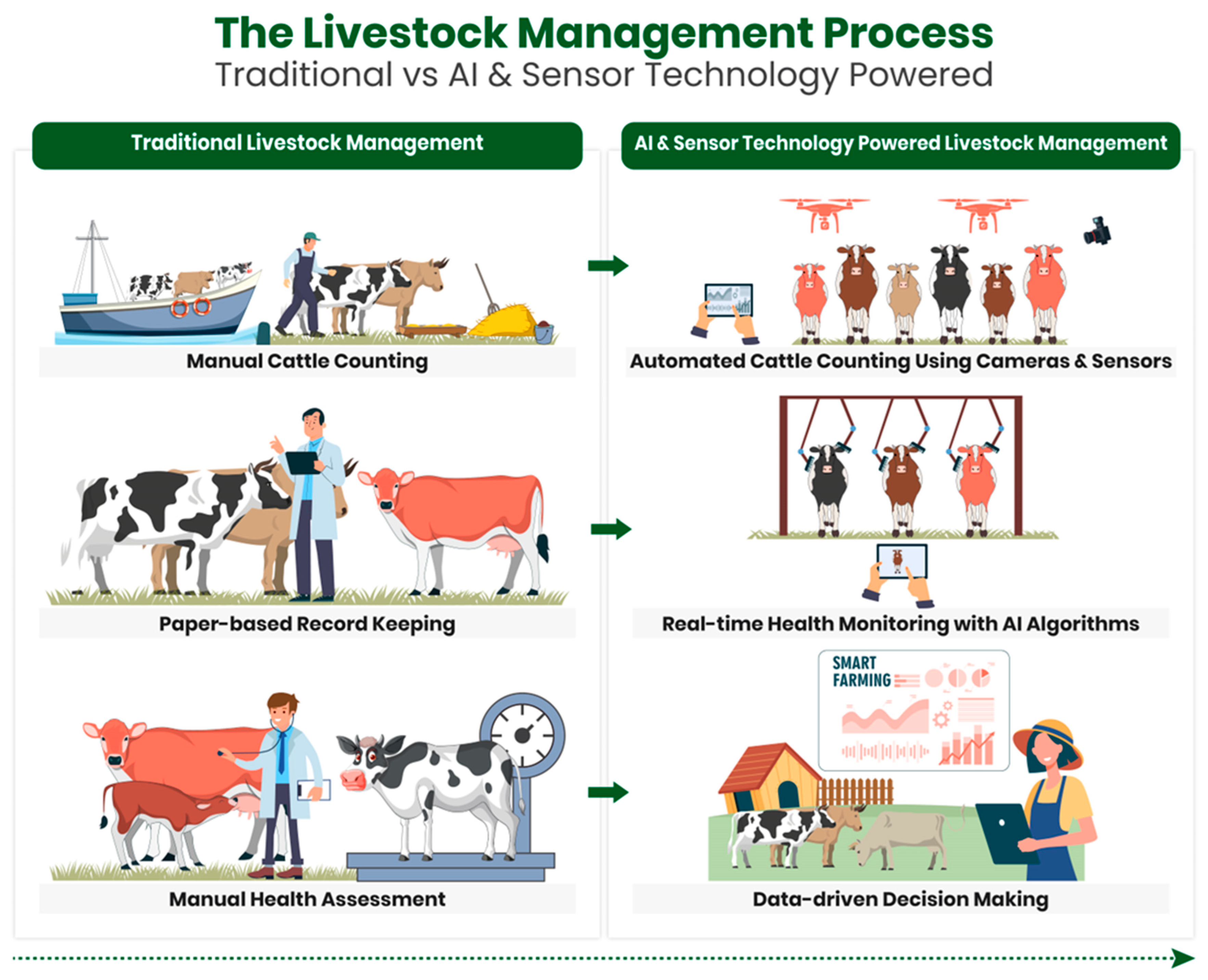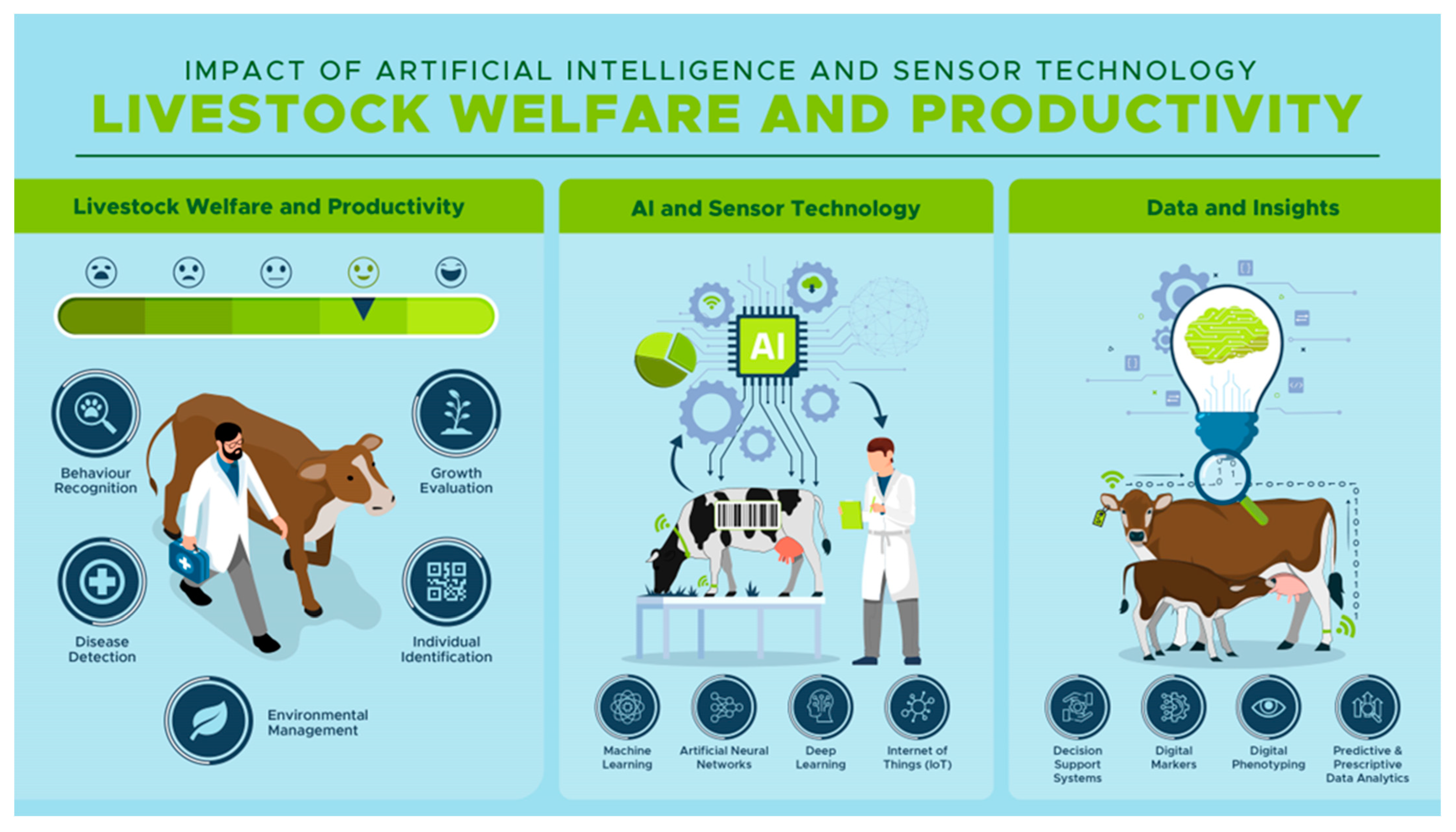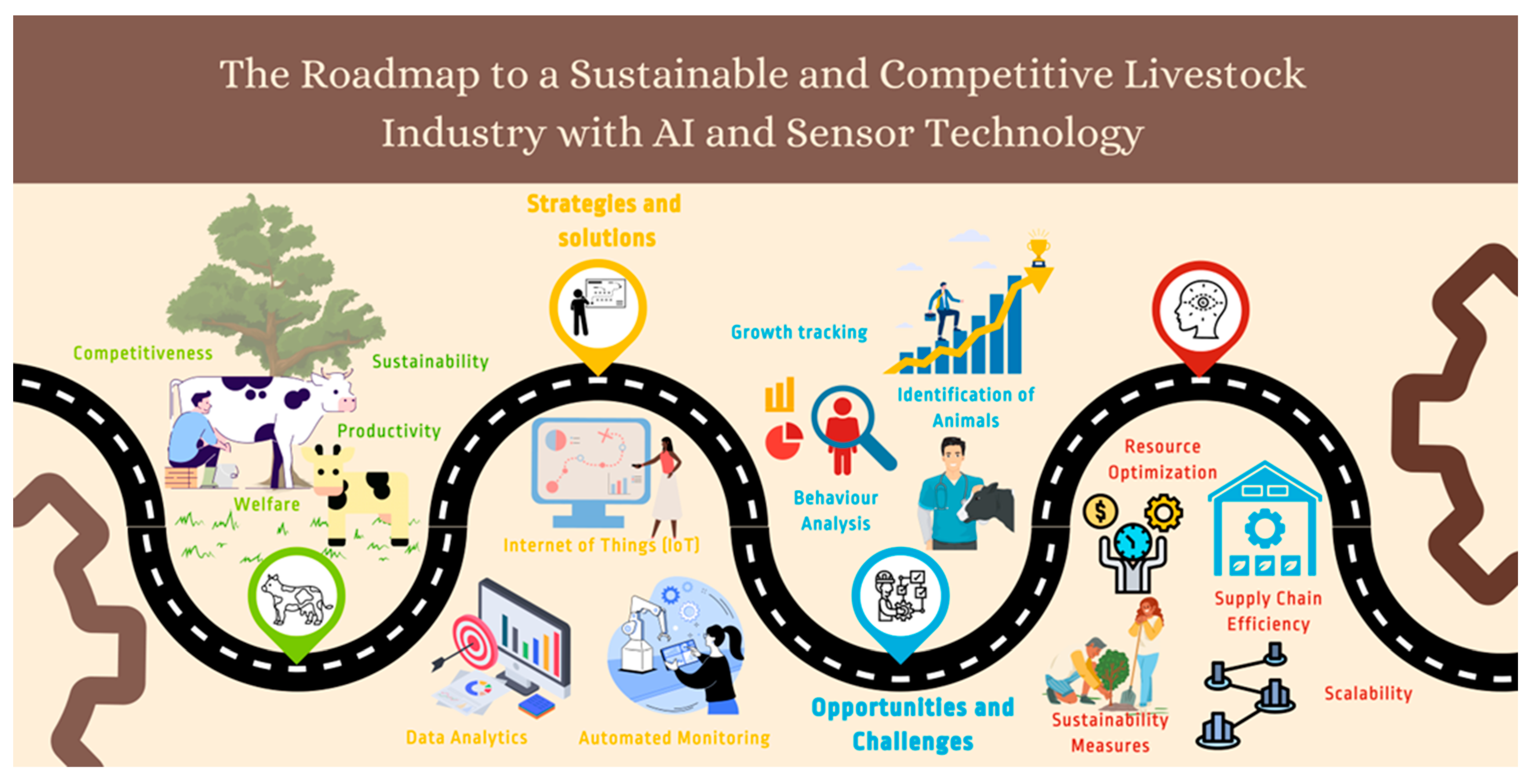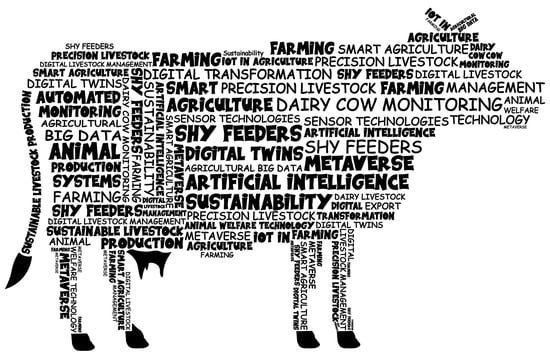Artificial Intelligence and Sensor Technologies in Dairy Livestock Export: Charting a Digital Transformation
Abstract
:1. Introduction
2. Application of AI and Sensor Technology in Livestock Management
3. Future Perspectives: AI and Sensor Technology in Livestock Management
3.1. Identifying Opportunities and Overcoming Challenges
3.2. Navigating towards a Sustainable and Competitive Livestock Sector
3.3. Applied Informatics for Dairy Livestock Export: Overcoming Big Data Challenges for Real-Time Analytics and Sustainable Practices
4. The Intersection of Sensor Technologies and Artificial Intelligence: A Closer Look
4.1. Sensor Technologies
4.2. Artificial Intelligence
4.3. Integration of Multiple Sensor Modalities
4.4. Advancements in AI Algorithms
4.5. Customization and Individual Animal Approach
4.6. Technological Adaptation and Training
4.7. Stakeholder Engagement and Consumer Perception
4.8. Data Security and Privacy
4.9. Economic Considerations
4.10. Ensuring Animal Comfort and Welfare
4.11. Technology Integration and Interoperability
4.12. Continual Monitoring and Evaluation
4.13. Challenges Associated with the Use of Sensors and IoT
5. Conclusions
Funding
Conflicts of Interest
References
- Neethirajan, S.; Kemp, B. Digital Livestock Farming. Sens. Bio-Sens. Res. 2021, 32, 100408. [Google Scholar] [CrossRef]
- Hoque, M.; Mondal, S.; Adusumilli, S. Sustainable Livestock Production and Food Security. In Emerging Issues in Climate Smart Livestock Production; Academic Press: Cambridge, MA, USA, 2022; pp. 71–90. [Google Scholar]
- Hashem, N.M.; González-Bulnes, A.; Rodriguez-Morales, A.J. Animal Welfare and Livestock Supply Chain Sustainability under the COVID-19 Outbreak: An Overview. Front. Vet. Sci. 2020, 7, 582528. [Google Scholar] [CrossRef] [PubMed]
- Koutouzidou, G.; Ragkos, A.; Melfou, K. Evolution of the Structure and Economic Management of the Dairy Cow Sector. Sustainability 2022, 14, 11602. [Google Scholar] [CrossRef]
- Neethirajan, S. Harnessing the Metaverse for Livestock Welfare: Unleashing Sensor Data and Navigating Ethical Frontiers. Preprints 2023. [Google Scholar] [CrossRef]
- Hing, S.; Foster, S.; Evans, D. Animal Welfare Risks in Live Cattle Export from Australia to China by Sea. Animals 2021, 11, 2862. [Google Scholar] [CrossRef]
- Collins, T.; Hampton, J.; Barnes, A. Literature Review of Scientific Research Relating to Animal Health and Welfare in Livestock Exports; Murdoch University: Perth, Australia, 2018. [Google Scholar]
- Katainen, A.; Norring, M.; Manninen, E.; Laine, J.; Orava, T.; Kuoppala, K.; Saloniemi, H. Competitive Behaviour of Dairy Cows at a Concentrate Self-Feeder. Acta Agric. Scand. Sect. A Anim. Sci. 2005, 55, 98–105. [Google Scholar] [CrossRef]
- Weigele, H.C.; Gygax, L.; Steiner, A.; Wechsler, B.; Burla, J.B. Moderate Lameness Leads to Marked Behavioral Changes in Dairy Cows. J. Dairy Sci. 2018, 101, 2370–2382. [Google Scholar] [CrossRef] [Green Version]
- Matore, Z. Drivers and Indicators of Dairy Animal Welfare in Large-Scale Dairies. Trop. Anim. Health Prod. 2023, 55, 43. [Google Scholar] [CrossRef]
- Martins, B.M.; Mendes, A.L.C.; Silva, L.F.; Moreira, T.R.; Costa, J.H.C.; Rotta, P.P.; Chizzotti, M.L.; Marcondes, M.I. Estimating Body Weight, Body Condition Score, and Type Traits in Dairy Cows Using Three Dimensional Cameras and Manual Body Measurements. Livest. Sci. 2020, 236, 104054. [Google Scholar] [CrossRef]
- Grant, R.J.; Ferraretto, L.F. Silage Review: Silage Feeding Management: Silage Characteristics and Dairy Cow Feeding Behavior. J. Dairy Sci. 2018, 101, 4111–4121. [Google Scholar] [CrossRef]
- Tassinari, P.; Bovo, M.; Benni, S.; Franzoni, S.; Poggi, M.; Mammi, L.M.E.; Mattoccia, S.; Di Stefano, L.; Bonora, F.; Barbaresi, A.; et al. A Computer Vision Approach Based on Deep Learning for the Detection of Dairy Cows in Free Stall Barn. Comput. Electron. Agric. 2021, 182, 106030. [Google Scholar] [CrossRef]
- Stygar, A.H.; Gómez, Y.; Berteselli, G.V.; Dalla Costa, E.; Canali, E.; Niemi, J.K.; Llonch, P.; Pastell, M. A Systematic Review on Commercially Available and Validated Sensor Technologies for Welfare Assessment of Dairy Cattle. Front. Vet. Sci. 2021, 8, 634338. [Google Scholar] [CrossRef]
- McDonagh, J.; Tzimiropoulos, G.; Slinger, K.R.; Huggett, Z.J.; Down, P.M.; Bell, M.J. Detecting Dairy Cow Behavior Using Vision Technology. Agriculture 2021, 11, 675. [Google Scholar] [CrossRef]
- Hansen, M.F.; Smith, M.L.; Smith, L.N.; Jabbar, K.A.; Forbes, D. Automated Monitoring of Dairy Cow Body Condition, Mobility and Weight Using a Single 3D Video Capture Device. Comput. Ind. 2018, 98, 14–22. [Google Scholar] [CrossRef]
- Neethirajan, S. Recent Advances in Wearable Sensors for Animal Health Management. Sens. Bio-Sens. Res. 2017, 12, 15–29. [Google Scholar] [CrossRef] [Green Version]
- Lee, M.; Seo, S. Wearable wireless biosensor technology for monitoring cattle: A review. Animals 2021, 11, 2779. [Google Scholar] [CrossRef]
- Llonch, P.; Mainau, E.; Ipharraguerre, I.R.; Bargo, F.; Tedó, G.; Blanch, M.; Manteca, X. Chicken or the Egg: The Reciprocal Association between Feeding Behavior and Animal Welfare and Their Impact on Productivity in Dairy Cows. Front. Vet. Sci. 2018, 5, 305. [Google Scholar] [CrossRef] [Green Version]
- Neethirajan, S. Transforming the Adaptation Physiology of Farm Animals through Sensors. Animals 2020, 10, 1512. [Google Scholar] [CrossRef] [PubMed]
- Tzanidakis, C.; Tzamaloukas, O.; Simitzis, P.; Panagakis, P. Precision Livestock Farming Applications (PLF) for Grazing Animals. Agriculture 2023, 13, 288. [Google Scholar] [CrossRef]
- Alshehri, M. Blockchain-Assisted Internet of Things Framework in Smart Livestock Farming. Internet Things 2023, 22, 100739. [Google Scholar] [CrossRef]
- Džermeikaitė, K.; Bačėninaitė, D.; Antanaitis, R. Innovations in Cattle Farming: Application of Innovative Technologies and Sensors in the Diagnosis of Diseases. Animals 2023, 13, 780. [Google Scholar] [CrossRef]
- Brault, S.A.; Hannon, S.J.; Gow, S.P.; Otto, S.J.; Booker, C.W.; Morley, P.S. Calculation of Antimicrobial Use Indicators in Beef Feedlots—Effects of Choice of Metric and Standardized Values. Front. Vet. Sci. 2019, 6, 330. [Google Scholar] [CrossRef]
- Tasdemir, S.; Urkmez, A.; Inal, S. Determination of Body Measurements on the Holstein Cows Using Digital Image Analysis and Estimation of Live Weight with Regression Analysis. Comput. Electron. Agric. 2011, 76, 189–197. [Google Scholar] [CrossRef]
- Qiao, Y.; Kong, H.; Clark, C.; Lomax, S.; Su, D.; Eiffert, S.; Sukkarieh, S. Intelligent Perception for Cattle Monitoring: A Review for Cattle Identification, Body Condition Score Evaluation, and Weight Estimation. Comput. Electron. Agric. 2021, 185, 106143. [Google Scholar] [CrossRef]
- Morrone, S.; Dimauro, C.; Gambella, F.; Cappai, M.G. Industry 4.0 and Precision Livestock Farming (PLF): An up to Date Overview across Animal Productions. Sensors 2022, 22, 4319. [Google Scholar] [CrossRef] [PubMed]
- Haldar, A.; Mandal, S.N.; Deb, S.; Roy, R.; Laishram, M. Application of Information and Electronic Technology for Best Practice Management in Livestock Production System. In Agriculture, Livestock Production and Aquaculture: Advances for Smallholder Farming Systems; Springer International Publishing: Cham, Switzerland, 2022; Volume 2, pp. 173–218. [Google Scholar]
- Darvazeh, S.S.; Vanani, I.R.; Musolu, F.M. Big Data Analytics and Its Applications in Supply Chain Management. In New Trends in the Use of Artificial Intelligence for the Industry 4.0; IntechOpen: London, UK, 2020; p. 175. [Google Scholar]
- Saleem, T.J.; Chishti, M.A. Deep Learning for the Internet of Things: Potential Benefits and Use-Cases. Digit. Commun. Netw. 2021, 7, 526–542. [Google Scholar] [CrossRef]
- Woschank, M.; Rauch, E.; Zsifkovits, H. A Review of Further Directions for Artificial Intelligence, Machine Learning, and Deep Learning in Smart Logistics. Sustainability 2020, 12, 3760. [Google Scholar] [CrossRef]
- Menendez, H.M., III; Brennan, J.R.; Gaillard, C.; Ehlert, K.; Quintana, J.; Neethirajan, S.; Remus, A.; Jacobs, M.; Teixeira, I.A.; Turner, B.L.; et al. ASAS–NANP Symposium: Mathematical Modeling in Animal Nutrition: Opportunities and Challenges of Confined and Extensive Precision Livestock Production. J. Anim. Sci. 2022, 100, skac160. [Google Scholar] [CrossRef]
- Bhat, S.A.; Huang, N.F.; Sofi, I.B.; Sultan, M. Agriculture-Food Supply Chain Management Based on Blockchain and IoT: A Narrative on Enterprise Blockchain Interoperability. Agriculture 2021, 12, 40. [Google Scholar] [CrossRef]
- Bhattarai, B.P.; Paudyal, S.; Luo, Y.; Mohanpurkar, M.; Cheung, K.; Tonkoski, R.; Hovsapian, R.; Myers, K.S.; Zhang, R.; Zhao, P.; et al. Big Data Analytics in Smart Grids: State-of-the-Art, Challenges, Opportunities, and Future Directions. IET Smart Grid 2019, 2, 141–154. [Google Scholar] [CrossRef]
- Klerkx, L.; Jakku, E.; Labarthe, P. A Review of Social Science on Digital Agriculture, Smart Farming and Agriculture 4.0: New Contributions and a Future Research Agenda. NJAS-Wageningen J. Life Sci. 2019, 90, 100315. [Google Scholar] [CrossRef]
- Liu, Y.; Ma, X.; Shu, L.; Hancke, G.P.; Abu-Mahfouz, A.M. From Industry 4.0 to Agriculture 4.0: Current Status, Enabling Technologies, and Research Challenges. IEEE Trans. Ind. Inform. 2022, 18, 5544–5557. [Google Scholar] [CrossRef]
- Saggi, M.K.; Jain, S. A survey towards an integration of big data analytics to big insights for value-creation. Inf. Process. Manag. 2018, 54, 758–790. [Google Scholar] [CrossRef]
- Neethirajan, S.; Reimert, I.; Kemp, B. Measuring farm animal emotions—Sensor-based approaches. Sensors 2021, 21, 553. [Google Scholar] [CrossRef]
- Herlin, A.; Brunberg, E.; Hultgren, J.; Högberg, N.; Rydberg, A.; Skarin, A. Animal welfare implications of digital tools for monitoring and management of cattle and sheep on pasture. Animals 2021, 11, 829. [Google Scholar] [CrossRef]
- Zhang, M.; Wang, X.; Feng, H.; Huang, Q.; Xiao, X.; Zhang, X. Wearable Internet of Things enabled precision livestock farming in smart farms: A review of technical solutions for precise perception, biocompatibility, and sustainability monitoring. J. Clean. Prod. 2021, 312, 127712. [Google Scholar] [CrossRef]
- Rejeb, A.; Rejeb, K.; Zailani, S.; Keogh, J.G.; Appolloni, A. Examining the interplay between artificial intelligence and the agri-food industry. Artif. Intell. Agric. 2022, 6, 111–128. [Google Scholar] [CrossRef]
- Mishra, S.; Sharma, S.K. Advanced contribution of IoT in agricultural production for the development of smart livestock environments. Internet Things 2023, 22, 100724. [Google Scholar] [CrossRef]
- Neethirajan, S. The Significance and Ethics of Digital Livestock Farming. AgriEngineering 2023, 5, 488–505. [Google Scholar] [CrossRef]
- Neethirajan, S. SOLARIA-SensOr-driven resiLient and adaptive monitoRIng of farm Animals. Agriculture 2023, 13, 436. [Google Scholar] [CrossRef]
- Kanjo, E.; Younis, E.M.; Ang, C.S. Deep learning analysis of mobile physiological, environmental and location sensor data for emotion detection. Inf. Fusion 2019, 49, 46–56. [Google Scholar] [CrossRef]
- Mancuso, D.; Castagnolo, G.; Porto, S.M. Cow Behavioural Activities in Extensive Farms: Challenges of Adopting Automatic Monitoring Systems. Sensors 2023, 23, 3828. [Google Scholar] [CrossRef]
- Hou, S.; Cheng, X.; Shi, L.; Zhang, S. Study on individual behavior of dairy cows based on activity data and clustering. In Proceedings of the 2020 2nd International Conference on Robotics, Intelligent Control and Artificial Intelligence, Shanghai, China, 17–19 October 2020; pp. 210–216. [Google Scholar]
- Tuyttens, F.A.; Molento, C.F.; Benaissa, S. Twelve threats of precision livestock farming (PLF) for animal welfare. Front. Vet. Sci. 2022, 9, 889623. [Google Scholar] [CrossRef] [PubMed]
- Wolfert, S.; Ge, L.; Verdouw, C.; Bogaardt, M.J. Big data in smart farming—A review. Agric. Syst. 2017, 153, 69–80. [Google Scholar] [CrossRef]
- Amiri-Zarandi, M.; Dara, R.A.; Duncan, E.; Fraser, E.D. Big data privacy in smart farming: A review. Sustainability 2022, 14, 9120. [Google Scholar] [CrossRef]
- Papst, F.; Saukh, O.; Römer, K.; Grandl, F.; Jakovljevic, I.; Steininger, F.; Mayerhofer, M.; Duda, J.; Egger-Danner, C. Embracing opportunities of livestock big data integration with privacy constraints. In Proceedings of the 9th International Conference on the Internet of Things, Bilbao, Spain, 22–25 October 2019; pp. 1–4. [Google Scholar]
- Faverjon, C.; Bernstein, A.; Grütter, R.; Nathues, C.; Nathues, H.; Sarasua, C.; Sterchi, M.; Vargas, M.E.; Berezowski, J. A transdisciplinary approach supporting the implementation of a Big Data project in livestock production: An example from the Swiss pig production industry. Front. Vet. Sci. 2019, 6, 215. [Google Scholar] [CrossRef]
- Dawkins, M.S. Does smart farming improve or damage animal welfare? Technology and what animals want. Front. Anim. Sci. 2021, 2, 736536. [Google Scholar] [CrossRef]
- Goedde, L.; Katz, J.; Ménard, A.; Revellat, J. Agriculture’s Connected Future: How Technology Can Yield New Growth; McKinsey and Company: Atlanta, GA, USA, 2020. [Google Scholar]
- Koltes, J.E.; Cole, J.B.; Clemmens, R.; Dilger, R.N.; Kramer, L.M.; Lunney, J.K.; McCue, M.E.; McKay, S.D.; Mateescu, R.G.; Murdoch, B.M.; et al. A vision for development and utilization of high-throughput phenotyping and big data analytics in livestock. Front. Genet. 2019, 10, 1197. [Google Scholar] [CrossRef] [PubMed] [Green Version]
- Shu, H.; Wang, W.; Guo, L.; Bindelle, J. Recent advances on early detection of heat strain in dairy cows using animal-based indicators: A review. Animals 2021, 11, 980. [Google Scholar] [CrossRef]
- Sejian, V.; Shashank, C.G.; Silpa, M.V.; Madhusoodan, A.P.; Devaraj, C.; Koenig, S. Non-Invasive Methods of Quantifying Heat Stress Response in Farm Animals with Special Reference to Dairy Cattle. Atmosphere 2022, 13, 1642. [Google Scholar] [CrossRef]
- Farooq, M.S.; Sohail, O.O.; Abid, A.; Rasheed, S. A survey on the role of iot in agriculture for the implementation of smart livestock environment. IEEE Access 2022, 10, 9483–9505. [Google Scholar] [CrossRef]
- Senoo, E.E.K.; Akansah, E.; Mendonça, I.; Aritsugi, M. Monitoring and Control Framework for IoT, Implemented for Smart Agriculture. Sensors 2023, 23, 2714. [Google Scholar] [CrossRef]
- Yadav, V.S.; Singh, A.R.; Raut, R.D.; Mangla, S.K.; Luthra, S.; Kumar, A. Exploring the application of Industry 4.0 technologies in the agricultural food supply chain: A systematic literature review. Comput. Ind. Eng. 2022, 169, 108304. [Google Scholar] [CrossRef]
- Debauche, O.; Trani, J.P.; Mahmoudi, S.; Manneback, P.; Bindelle, J.; Mahmoudi, S.A.; Guttadauria, A.; Lebeau, F. Data management and internet of things: A methodological review in smart farming. Internet Things 2021, 14, 100378. [Google Scholar] [CrossRef]
- Andronie, M.; Lăzăroiu, G.; Iatagan, M.; Hurloiu, I.; Dijmărescu, I. Sustainable cyber-physical production systems in big data-driven smart urban economy: A systematic literature review. Sustainability 2021, 13, 751. [Google Scholar] [CrossRef]
- Gehlot, A.; Malik, P.K.; Singh, R.; Akram, S.V.; Alsuwian, T. Dairy 4.0: Intelligent Communication Ecosystem for the Cattle Animal Welfare with Blockchain and IoT Enabled Technologies. Appl. Sci. 2022, 12, 7316. [Google Scholar] [CrossRef]
- Jukan, A.; Masip-Bruin, X.; Amla, N. Smart computing and sensing technologies for animal welfare: A systematic review. ACM Comput. Surv. 2017, 50, 10. [Google Scholar] [CrossRef] [Green Version]
- Cockburn, M. Application and prospective discussion of machine learning for the management of dairy farms. Animals 2020, 10, 1690. [Google Scholar] [CrossRef]



| Application | AI and Sensor Technology Role | Specific Technology Used | Benefits | Limitations |
|---|---|---|---|---|
| Identification of ‘Shy Feeders’ | Uses AI and video analytics to spot ‘shy feeder’ behavior through RFID tag data analysis. | RFID tags, computer vision, machine learning algorithms | Aids early identification and intervention, improving herd health and productivity. Enables personalized nutrition plans. | Needs sensor setup and careful AI calibration to minimize false results. |
| Monitoring of Feeding Behaviors | Sensors track feeding metrics with AI identifying abnormal patterns in real time, offering actionable insights. | Feed intake sensors, IoT (Internet of Things) connectivity, cloud computing, machine learning algorithms | Gives real-time insights into animal health and nutrition status, enabling timely interventions. Helps prevent over/underfeeding. | Requires robust connectivity and sensor maintenance for real-time monitoring. |
| Automation of Weight Collection | Sensor-based walk-over-weighing systems with AI interpretation for automatic weight collection. | Walk-over-weighing systems, IoT connectivity, cloud computing, machine learning algorithms | Provides accurate, hassle-free weight tracking. Allows continuous monitoring of animal performance. Assists in adjusting feeding strategies. | Requires animal training to use the system, sensor calibration and maintenance for accurate readings. |
| Aspect | AI and Sensor Technology Role | Specific Technology | Benefits | Challenges |
|---|---|---|---|---|
| Automated Cattle Counting | Facilitates accurate, efficient cattle counting using AI-powered image processing. | Machine vision systems, image recognition algorithms | Minimizes human errors, accelerates counting, allows real-time livestock tracking. | Setup needs for cameras and processing systems, varying accuracy due to lighting and cattle movement. |
| Supply Chain Traceability | Uses sensors for location and condition tracking throughout the supply chain, coupled with AI for real-time tracking and issue prediction. | GPS trackers, RFID tags, IoT connectivity, Big Data Analytics | Boosts traceability, promotes animal welfare through timely interventions, assists in regulatory compliance. | Demands robust sensor network and data management, potential privacy concerns with location tracking. |
| Market Development | Leverages AI for market trend analysis, demand-supply dynamics, and price fluctuations, offering predictive insights for production and exports. | Machine Learning algorithms, big data analytics | Promotes proactive decision making, optimizes market demand fulfilment, potentially increases profits. | Relies on comprehensive market data, requires advanced AI models for accurate predictions. |
Disclaimer/Publisher’s Note: The statements, opinions and data contained in all publications are solely those of the individual author(s) and contributor(s) and not of MDPI and/or the editor(s). MDPI and/or the editor(s) disclaim responsibility for any injury to people or property resulting from any ideas, methods, instructions or products referred to in the content. |
© 2023 by the author. Licensee MDPI, Basel, Switzerland. This article is an open access article distributed under the terms and conditions of the Creative Commons Attribution (CC BY) license (https://creativecommons.org/licenses/by/4.0/).
Share and Cite
Neethirajan, S. Artificial Intelligence and Sensor Technologies in Dairy Livestock Export: Charting a Digital Transformation. Sensors 2023, 23, 7045. https://doi.org/10.3390/s23167045
Neethirajan S. Artificial Intelligence and Sensor Technologies in Dairy Livestock Export: Charting a Digital Transformation. Sensors. 2023; 23(16):7045. https://doi.org/10.3390/s23167045
Chicago/Turabian StyleNeethirajan, Suresh. 2023. "Artificial Intelligence and Sensor Technologies in Dairy Livestock Export: Charting a Digital Transformation" Sensors 23, no. 16: 7045. https://doi.org/10.3390/s23167045
APA StyleNeethirajan, S. (2023). Artificial Intelligence and Sensor Technologies in Dairy Livestock Export: Charting a Digital Transformation. Sensors, 23(16), 7045. https://doi.org/10.3390/s23167045







